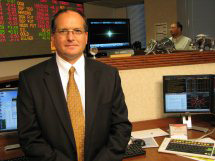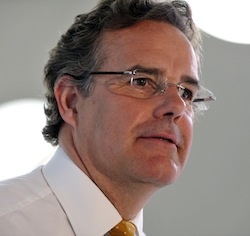Occupy Wall Street may have dissipated, but big banks have had little respite from critics in recent months, as they have been besieged by negative headlines regarding trading losses and an interest-rate scandal. With regulators in the U.S. and Europe poised to rein in banking activities and by extension profitability, it’s safe to say that Wall Street has seen sunnier days.
Yet what can go underreported amid the regulatory probes and the executive testimony is that by and large, sell-side banks continue to effectively execute on their raison d’être: providing value for buy-side investors.
For example, Goldman Sachs’ institutional client services business generated net revenue of $3.89 billion in the second quarter; that was 32% less than the first quarter, but 11% more than the year-earlier quarter. The $3.89 billion comprised 59% of Goldman’s overall net revenue for the quarter; as an indication of the size of the business, on an annualized basis Goldman’s institutional client services would rank #160 on the Fortune 500 list.
“The sell side is doing well in carrying out its traditional core business: custodial, trading execution, technology provided on clients’ desks, and research,” said Arun Kaul, chief investment officer at Fort Lauderdale, Florida-based hedge fund Olympian Capital Management. “Analysts are more accurate today in their forecasts. Generally speaking, their research is very good, including the ability to look at the macro situation.”
In a difficult market environment for both the sell side and the buy side, Wall Street banks are seeking to prune costs and limit spending, without constraining their capacity to provide the right products and services. As with any business, cutting too much would impair the product and result in customers defecting to competitors.
“We’ll need to continue to allocate resources effectively to meet our clients’ need to maximize returns,” Goldman Sachs Chief Financial Officer David Viniar said on a July 17 conference call to discuss the company’s earnings. “We will continue to focus on helping our clients navigate the challenging market conditions.”
TRADING & RESEARCH

Steve Hedger, managing director of trading and investment operations at Fifth Third Asset Management
“Almost every single large broker-dealer does a much better job with pre-trade and post-trade analytics in close to real time.”
Steve Hedger, managing director of trading and investment operations at Fifth Third Asset Management in Cincinnati, noted that trading and research are the sell side’s mainstay offerings. “With trading, the main thing has been technology,” Hedger told Markets Media. “What these guys have done is ramp up and take the technology that really had been more on their desktops, and move it to the buy side’s desktop. They have put their trading tools on our desktops, and they continue to enhance the functionality.”
“In the old days we used to call the sellside sales trader,” Hedger continued. “Now we call their technology helpdesk, and we have a technology contact who can help us customize algorithms and explain the utilization of the feature functionality.”
In Hedger’s view, the core research product of the sell side hasn’t changed much over the years, aside from banks being more economical in providing coverage, and deploying a wider variety of media and electronic communications tools to disseminate the product.
“With research the biggest value is and always was, access to company management,” Hedger said. The sell side “has the relationships. They orchestrate road shows, conferences, and conference calls, they can come to us, or we can travel to them. They have big, and strong, relationships with corporations.”
“On a more granular level, look at Transaction Cost Analysis and the analytics of the trading desk,” Hedger said. “There used to be just two big providers, and you would have to wait until the end of the month (for data). Now almost every single large broker-dealer does a much better job with pre-trade and post-trade analytics in close to real time, which is very helpful.”
Sell-side offerings are much better than they used to be, and there is “certainly” evidence of ongoing improvement, Hedger said.
In July, Deutsche Bank announced the launch of its “next generation” trading platform for foreign exchange, which combines electronic and voice trading across execution channels and provides direct research and real-time commentary alerts from the trading floor. Morgan Stanley’s new Matrix platform for hedge funds consolidates information across multiple asset classes and provides a single access point across multiple Morgan Stanley businesses. Bank of America Merrill Lynch says its Instinct algorithm encompasses new features such as different trade-urgency settings, a quantitative model that calculates trade feasibility, and improved cancel/replace functionality
To be sure, not every enhancement or upgrade of a sell-side product or service is meaningful for a buyside customer. But in aggregate, the improvements are important and underscore the sell side’s value proposition, as the buy side does not have the wherewithal to build such an infrastructure, let alone regularly boost its functionality.
“We have to pay attention to the changes,” Hedger said. “When they become available, we need to evaluate them, and utilize them if applicable to our trading styles.”
As the sell side as stepped up its game, so has the buy side in terms of its evaluation of sell-side services, whether in-house or via a third party. The byproduct of the new dynamic can be a virtuous cycle of sorts, as more extensive and sophisticated analysis by the buy side provides greater motivation for the sell side to improve its products.
“The sell side has generally gotten better at building technology and pairing it with their financial-product offerings, while the buy side is much more adept at evaluating technology than they were even five years ago,” said Daryan Dehghanpisheh, global director of financial services at Intel. “This is creating an interesting dynamic.”
“The buy side is doing well in getting much smarter about how to evaluate technology and the technological capacity of the sell side,” Dehghanpisheh said. “In particular, we’re starting to see companies like Goldman Sachs partnering with Pico Trading; this is an interesting model to sell to a buy-side institution, in that tech leadership can come from a third party, but all of the book-keeping can be handled by a large sell-side institution.”
Dehghanpisheh said the Goldman- Pico partnership contrasts with Morgan Stanley’s approach, which is to offer an all-in-one service capability, with some exceptions of relying on third parties.
CAPITAL EFFICACY
In Dehghanpisheh’s view, Morgan Stanley, JPMorgan Chase, and Credit Suisse are leaders in improving capital efficacy, which includes effectively moving into new trading types and positions; clearing a rising bar for regulation and compliance; and using capital more efficiently for the bank and its shareholders.
One trend in particular has fed into the sell side stepping up their value proposition: market fragmentation. Years ago when stocks would trade almost exclusively on the New York Stock Exchange or Nasdaq, it wasn’t especially difficult to route trades to one or the other. Today, with 13 stock exchanges in the U.S. alone, plus several dozen dark pools and other alternative trading systems, connectivity and determining the best trade venue is a much more complex and laborious task.
“What has really created this intersection of technology services and sales along with traditional and non-traditional financial-product sales, was the creation of dark pools and new venues,” Dehghanpisheh said. “If you offer those liquidity venues, you have to have a technological advantage and a reason to bring liquidity and trades to that spot. This is a tipping point.”
“The sheer number of destinations that they get the option to reach, and the complexity associated with managing the process, are very significant things,” said Kevin Covington, chief executive of London-based ITRS, a provider of riskmanagement and performance-monitoring software. “What the buy side is asking the sell side to provide, in terms of the number of venues to connect to, the number of channels, ensuring that all services are available all the time, and ensuring buy-side choice, is massive.”
Added Covington, “if the buy side tried to replicate that directly or via service providers, it would be a very large burden in terms of the sheer infrastructure required to connect to multiple venues, understand performance, and ensuring that the infrastructure is resilient.”
One closely watched step in that direction is investment-management giant BlackRock’s plan to launch a bondtrading platform later this year. The idea behind Aladdin is to match buyside trades with other buy-side trades without the sell side being involved. However, the platform is meant to supplement rather than replace the sell side; further, previous industry attempts to bypass the sell side did not work out.
“BlackRock’s Aladdin is in an interesting move, although I don’t see this as a new trend,” Covington said. “Something similar was attempted some years ago with E-Crossnet, which was acquired by ITG. Back then it really did struggle to achieve what it set out to do in the markets, which was to enable the buy side to cross and match, and only go to market for things they couldn’t match.”
“Even though this is not a new idea, the market dynamics have changed in recent years. So it will be interesting to see how it works this time, compared with previous attempts,” Covington added.

Kevin Covington, chief executive, ITRS
“A lot of people underestimate the sheer task and the degree and complexity of providing services, framework and infrastructure.”
Just as a critical fourth-quarter interception in a football game could end up as the headline, the missteps of sellside banks are often widely publicized, while the day-to-day business — akin to blocking and tackling on every play — goes little noticed.
“Despite the JPM ‘whale’ trader and other headlines, the sell side generally has done a good job on improving risk analytics systems,” Dehghanpisheh said. “They have spent lot of human, intellectual, and actual capital to get real-time, firm-wide risk closer to reality.”
“As the world continues down the path toward electronically cleared markets, what you end up with is a lot of different sell-side institutions looking for the right model of how to service the buy side,” Dehghanpisheh continued. Also, “sell-side institutions have to be big enough and flexible enough to work across regulatory and market-structure boundaries.”
The infrastructure of a sell-side firm is less and less distinguishable from that of its rivals, Dehghanpisheh noted. This increasingly commoditized and standardized architecture keeps costs in line and forces the differentiation down to the software product.
“Think about it this way – as a consumer, you don’t care what infrastructure Amazon or iTunes uses to deliver music. You just care that you get a fast download, a good player, and quality sound, at the best price or a price you feel is fair,” Dehghanpisheh said.

Daryan Dehghanpisheh, global director of financial services at Intel
“For the bulk of the buy side, the type of infrastructure doesn’t matter, but the service capability, offering flexibility, and lowest cost matter.”
The buy side cares about software, algorithms, and trading systems and solutions, Dehghanpisheh said. Some institutional investors care about latency, but increasingly this is more about determinism, or the ability to execute a very high percentage of trades at a reasonably fast speed, rather than just about the fastest latency, or trade execution that is super-fast but can only happen sometimes.
“From the product point of view, we certainly see the sell side doing an awful lot to try to improve the scope and quality of services offered to the buy side,” said Covington of ITRS, whose services include monitoring latency and trade flow, directing trades to the best execution venues, managing speed and reliability demands and providing predictive analytics. “There is a drive to be more competitive, and a lot of investment ‘spend’ and technology provision to try to satisfy the needs of buy-side customers in terms of trade flow and services provided around that.”
DIVERGING PERFORMANCE
Generally strong performance by the sell side in delivering value to the buy side, amid missteps elsewhere, could lend support to the notion that big banks should be broken up. Just recently, former Citigroup Chairman Sandy Weill – himself the architect of a financial conglomerate in the late 1990s – suggested banks should be broken up, and other industry observers opined that banks stocks would soar if the firms were split.
Big banks have lobbied against the socalled Volcker Rule, the initiative within the Dodd-Frank Act that aims to protect lending capacity and cut systemic risk by prohibiting banks from certain types of trading on behalf of their own account. It is unclear whether the JPMorgan trading loss would have been averted if a finalized Volcker Rule had been law, but an argument can be made that big banks would be better off by focusing exclusively on clients rather than playing the markets themselves.
“Trouble arises wherein they either trade in proprietary accounts, trade to their advantage or have subtle or not-sosubtle conflicts of interests versus their clients,” said Kaul of Olympian Capital.





